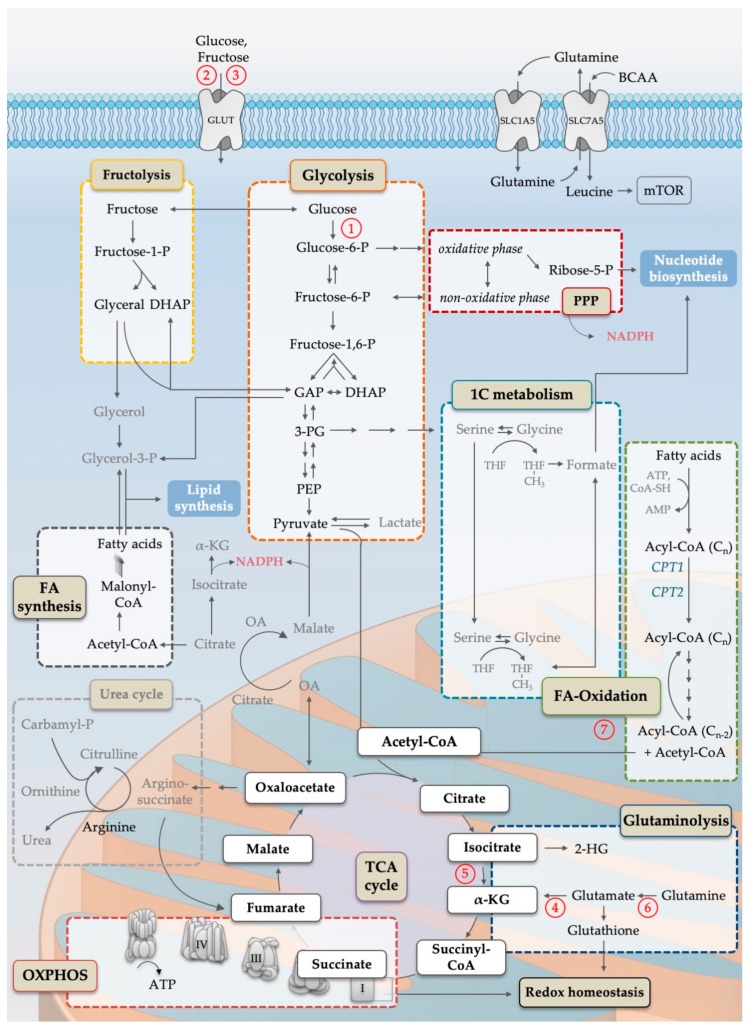Figure 1.
Simplified scheme of the cellular metabolism pathways important for AML pathophysiology. Names in colored boxes indicate major metabolic pathways. Oxidation of glucose in the course of glycolysis (orange box) generates carbon intermediates that can be metabolized in the pentose-phosphate-pathway (PPP, dark red box) and one-carbon metabolism (1C, blue box), both generating substrates for nucleotide biosynthesis. Parts of PPP as well as reactions catalyzed by IDH and malic enzymes are the main producer of cytosolic NADPH. Enzymatic degradation of fructose by fructolysis (yellow box) provides carbon intermediates for the glycolytic pathway as well as substrates for lipid synthesis. Acetyl-CoA, generated by glycolysis, fructolysis or fatty acid β-oxidation (green box), is the starting point for the mitochondrial tricarboxylic acid cycle (TCA, purple circle), which is essential to ensure oxidative phosphorylation (OXPHOS, red box). Acetyl-CoA is used for the condensation reaction of oxaloacetate to citrate. Citrate can be further processed to generate cytosolic acetyl-CoA for fatty acid synthesis (grey box). Furthermore, TCA cycle intermediates, e.g., oxaloacetate, are linked to the urea cycle, an important arginine source. In contrast, anaplerotic reactions, such as glutaminolysis (dark blue box), replenish the TCA cycle. Additionally, glutaminolysis is important for the synthesis of glutathione, a major player in maintaining cellular redox homeostasis. The exchange of glutamine to branched chain amino acids (especially leucine) is known to be a main activator of mammalian target of rapamycin complex 1 (mTORC1) signaling, directly linking metabolites to anabolic growth programs resulting in nucleotide, lipid and, in particular, protein synthesis. Single arrows indicate preferred direction of reactions of the main pathways, while multiple arrows indicate multiple reaction steps. Abbreviations: 1C; one carbon; 2-HG, 2-hydroxyglutarate; 3-PG, 3-phosphoglyceric acid; α-KG, alpha ketoglutarate; AMP, adenosine monophosphate; ATP, adenosine triphosphate; BCAA, branched chain amino acids; CoA, coenzyme A; CPT, carnitine palmitoyl transferase; DHAP, dihydroxyacetone phosphate; FA, fatty acid; GAP, glyceraldehyde-3-phosphate; GLUT, glucose/fructose transporter family; mTOR, mammalian target of rapamycin; NADPH, nicotinamide adenine dinucleotide phosphate; OA, oxaloacetate; OXPHOS, oxidative phosphorylation; -P, -phosphate; PEP, phosphoenolpyruvate; PPP, pentose-phosphate pathway; SLC, solute carrier family; TCA, tricarboxylic acid; THF, tetrahydrofolate. Circled numbers refer to metabolic response determinants in AML that are discussed in the Conclusion section.

